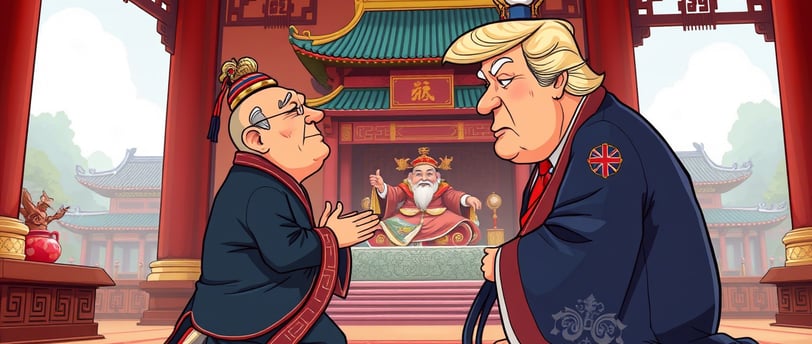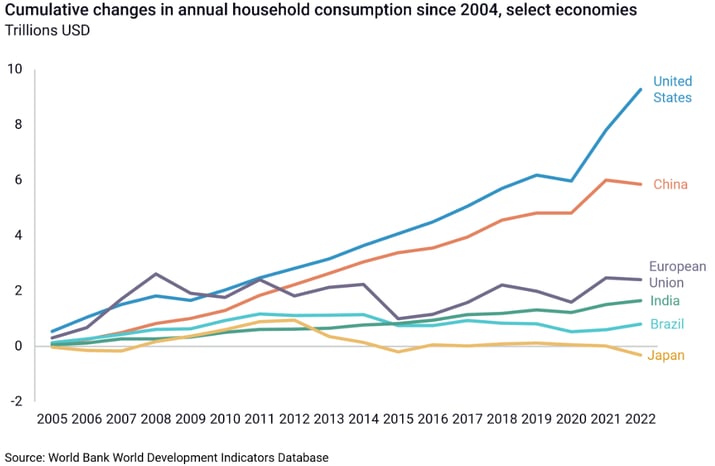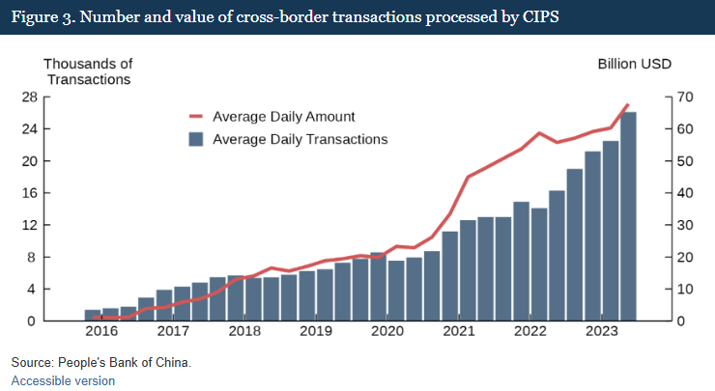Trump vs. China: Who Will Pay the Price for the Tariff War?
Donald Trump's aggressive tariff policy against China shook the very foundations of global trade. This article deconstructs the premises, missteps, and profound consequences of a strategy that promised much but, for many, delivered little.
I. L. R.
5/8/20256 min read


Cracks in Trump's Script
In a previous post, we undertook an analysis of the underlying motivations that drove Donald Trump's administration to implement a notably aggressive tariff policy.
Initially, our interpretation suggested that these measures constituted an unconventional declaration of war, primarily aimed at China.
While we had already warned that the U.S. economy faced multiple, complex challenges—such as inflation, a considerable fiscal deficit, diminishing global influence, a process of deindustrialization, and internal political tensions, among others—the apparent resolve shown by Trump seemed to lend him a degree of credibility and significant negotiating power.
Under this premise, we assumed that the Trump administration's stance would be definitive and that its fundamental objective was to redefine the rules of the game, seeking to position the United States more advantageously in its strategic confrontation with China.
Furthermore, we considered that any correction or reversal of this policy would only exacerbate uncertainty, without substantially improving the U.S.'s strategic position on various economic and geopolitical fronts.
However, the course of events has diverged from our initial forecasts. Consequently, this article will focus on re-evaluating the current scenario, aiming to elucidate the logic underlying the evolution and repercussions of this turbulent tariff saga.
Impact of the Tariff Chaos
Firstly, the international image of the United States has suffered significant deterioration. The tariff escalation with China, triggered after the so-called 'liberation day', led the White House to retract its previous threats against the Asian power. This retraction has not only undermined the Trump administration's negotiating capacity but has also highlighted the intrinsic fragility of the U.S. economy and its considerable external dependence.
In this context, its ability to exert pressure on other nations—especially China—will predictably be diminished. During the 90-day tariff truce, it is plausible that various nations will evaluate alternatives to U.S. impositions, while China, in response to the pressures, positions itself as a commercial counterweight to what could be perceived as coercion by the then-Republican administration.
Concurrently, the primary goal of reindustrialization seems to be fading. As we previously noted, “to attract investment, it's crucial to maintain a coherent narrative and project certainty about the continuity of protective tariffs.” Consequently, it is improbable that large-scale investments will materialize in a legal and fiscal environment characterized by such unpredictability.
Additionally, the cost of financing for the United States has risen, and growing economic uncertainty threatens to negatively impact both the private sector and the labor market, even if not all proposed tariffs are ultimately implemented. The only indicators that could be interpreted as moderately positive stem from recent inflation data and some nominal progress in negotiations concerning Ukraine.
However, from a realistic standpoint, progress concerning Ukraine can hardly be deemed substantial until a tangible path towards lasting peace between Russia and Ukraine is outlined, a scenario that seems unlikely in the short term. The narrative of diplomatic approch with Russia, promoted by the Trump administration, appears to diverge from factual reality, suggesting instead empty rhetoric, devoid of any genuine will to resolve the conflict. Proof of this is the virtual absence of significant progress in peace negotiations since that administration took office. Added to this is Xi Jinping's notable attendance at the Victory Day military parade in Moscow on May 9th, an invitation not extended to the U.S. president.
In this dynamic, Russia appears to hold an advantageous position, imposing conditions difficult for both Ukraine and the United States to accept. From Russia's perspective, its demanding stance in peace negotiations is understandable, given the history of snubs and harassment of the Kremlin by the Western bloc in recent decades, which has not heeded Putin's demands nor endorsed agreements aimed at reducing tensions between the two blocs.
In summary, the situation for the Trump administration is, unquestionably, more precarious than it was after the rather anticlimactic 'liberation day.'
Trump's Miscalculation?
At this juncture, two main possible explanations emerge for this unconvenient situation.
Firstly, one might consider the possibility that the Trump administration's genuine objectives are hidden and differ from those publicly declared: to compete effectively with China and foster U.S. reindustrialization.
This hypothesis seems, by all accounts, unlikely.
Certainly, China represents the most significant challenge to the U.S.'s hegemonic position, given its competitive advantages in industrial-technological, political, demographic, and sociocultural spheres, as well as its dynamism in many other factors driving its economy at a sustained pace towards eventual global leadership.
Ceding such preeminence is, from the U.S. perspective, an unacceptable eventuality. U.S. global primacy is the pillar supporting its robust domestic consumption, its firm geopolitical and geoeconomic control, the international leadership of its private sector, and the dollar's position as the dominant reserve currency. Consequently, containing China's rise stands as an existential issue for the United States.
As Scott Bessent stated in a recent address: “China cannot maintain such low levels of domestic consumption. China needs to balance its economy, and so do we. We would like to do it together.”
However, altering the status quo and granting the American economy time to rebalance does not align with China's strategic interests. The trends reflected in economic data are, in this regard, unequivocal.
Contrary to Bessent's assertions, China's domestic consumption continues its upward trajectory and remains balanced with investment, savings, and economic growth. Its geostrategic positioning is progressively strengthening through the formalization of bilateral agreements. Its military capabilities are rapidly expanding, and its industries are already at the forefront in key sectors such as aerospace, energy, and telecommunications, among others.
Furthermore, the government has paid special attention to education to lay the foundations for long-term innovation and development. In contrast, across the Pacific, the Trump administration proposed cuts in education spending.
Finally, the use of the yuan in international transactions via the CIPS system is expanding with increasing speed among its trading partners.
While it is true that the Chinese economy is not without vulnerabilities—such as its significant dependence on external demand, a high level of private sector debt, a real estate crisis that still lingers in certain regions, and the challenges inherent in its demographic evolution—the Asian giant seems reasonably prepared to face these challenges. This resilience is partly based on the considerable dependence other nations have on its economy, signs of progressive stabilization in the real estate sector, and the sustained increase in its productivity and innovation.
The United States, for its part, faces serious difficulties in sustaining an economy with both trade and fiscal deficits and is unable to reverse this dynamic without risking a severe economic crisis or a significant deterioration of the dollar's dominant position.
Scott Bessent's statements could, therefore, be interpreted as a distortion of reality. It is the U.S. economy, not China's, that urgently requires rebalancing.
For all these reasons, in seeking an explanation for the tariff bewilderment, the most plausible hypothesis points to an alarming lack of economic expertise and, perhaps, an erratic strategic compass on the part of the Trump administration. This combination has resulted in an inability to manage the situation towards a pragmatic and favorable outcome for the long-term interests of the United States and, by extension, its voters.
The initial strategy, combining a strong warning to Beijing and the international community with a subsequent proposal for cooperation, appeared to be a bold tactic, not without risks, but with considerable potential to achieve, at the very least, a favorable outcome. However, the concrete implementation of this strategy by the White House suggests an execution many would describe as amateurish, more akin to improvisation than calculated high-level diplomacy.
The initial error in judgment, when analyzing Trump's strategy, was to assume that a correct identification of U.S. vulnerabilities vis-à-vis China would necessarily translate into competent management of the situation by his administration. However, the observed results demonstrate that said administration is not up to such an extraordinary challenge.
The Shadow of an Empire: The Decline of the West
For decades, the United States has relied on the privileges derived from its financial and military supremacy, placing them at the service of its private sectors and lobbies, while neglecting the general welfare of its citizenry.
When the United States looks in the mirror, it will only see a country with mediocre infrastructure, a weakened cultural and educational fabric, and a society marked by exacerbated individualism and a materialism characteristic of post-Protestant liberal-progressive decay.
Its prosperity has been anchored in mass consumption, driven partly by the – now questioned – strength of its currency and by a techno-financial sector whose influence and practices are under scrutiny.
In short, a country devoid of spirit and collective purpose, headed for fragmentation and utter oblivion.
When structures of power, both state and oligarchic, require popular support to face the challenges of the new global paradigm, they will find a disengaged citizenry, reluctant to defend a system perceived as distant or neglectful of their fundamental needs; a system for which it is no longer worth fighting.
And those who do will fight for a political zombie that has abandoned the principles of democracy and the rule of law. They will fight for prostituted ideals. They will fight, not for a living and creative culture, but for a sterile civilization.




